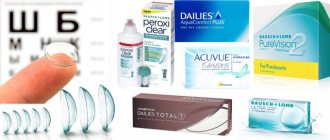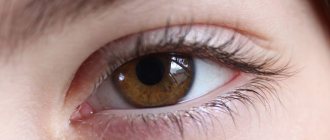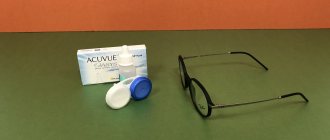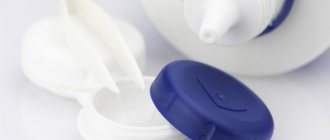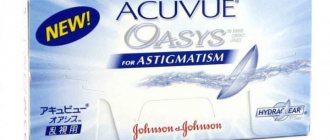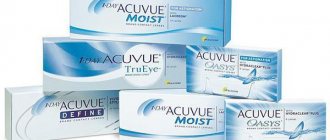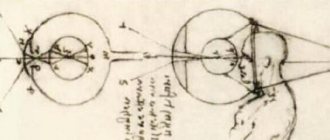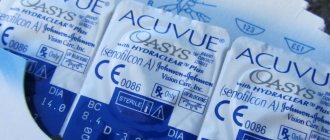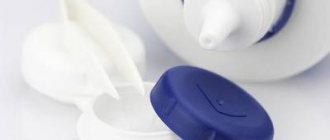Contact optics today are made from soft materials, which are at least ⅓ water. It is not only comfortable, but also safe, and therefore suitable for almost everyone. However, there are still contraindications to it. They are temporary and absolute. Let's find out who shouldn't wear contact lenses and why.
The first contact lenses were made of polymethyl methacrylate, a transparent plastic also called organic glass. Such ophthalmic products were rigid, they did not allow oxygen to pass through well and caused hypoxia, and they were not suitable for everyone. Many never managed to get used to contact optics of this type. There were also many contraindications to wearing it. Everything changed when hydrogel polymers began to be used in the production of lenses. They consist of 30-80% liquid, depending on the specific model. In addition, hydrogel products allow air to pass through better than plexiglass models. The popularity of contact correction products has instantly increased. Every year the demand for them increases. But contraindications for wearing contact lenses are still being identified in patients. These restrictions can be divided into several groups: absolute and temporary, ophthalmological and non-ophthalmological. Let's look at them in order and find out who should not wear lenses.
Eye diseases for which you cannot wear lenses
You can purchase contact optics only after an examination, during which the doctor determines whether there are contraindications to wearing them or not.
The list of eye diseases for which it is not recommended to wear lenses is quite extensive. But most of these diseases represent temporary restrictions. After complete recovery from a particular illness, a person can again wear contact correction products. We list the most common ophthalmopathologies for which it is better to abandon contact lenses for a certain period:
Inflammatory and infectious eye diseases - uveitis, keratitis, blepharitis, conjunctivitis, etc. They are accompanied by lacrimation, itching, burning in the eyes. A foreign object, which is the lens, will aggravate these symptoms, resulting in severe discomfort. If there is tearing, the product will constantly shift, which will reduce the quality of refractive error correction. This is not all the consequences of wearing contact optics for such eye diseases. Most of them have a viral or bacterial etiology. Viruses and bacteria remain on the surface of the lenses. It is quite difficult to remove them even with the help of modern cleaners. Doctors even recommend throwing away products that were used before the disease and not wearing them after recovery. The problem cannot be solved using one-day models. As already noted, the lenses will bring nothing but discomfort.
Glaucoma after surgery. In a person with this disease, intraocular pressure increases. You can wear contact lenses, but only if the glaucoma is compensated, that is, its treatment leads to normalization of pressure in the eyes. Contact optics are contraindicated after surgery. Such pathologies are treated by creating additional channels for the outflow of aqueous humor from the eyeball. As a rule, they occur at the junction of the sclera and the cornea. Contact optics can put pressure on this area of the eye, preventing intraocular fluid from leaving the eye. After surgical treatment of glaucoma, it is advisable to wear glasses. However, in some cases, doctors allow the use of lenses for correction. Much depends on medical indications and individual characteristics of the body.
Obstruction of the lacrimal ducts. Contact lenses for this pathology further slow down the rate of tear outflow. It will accumulate, causing diplopia. In addition, the risk of developing infectious diseases increases.
Reduced sensitivity of the cornea. If an eyelash or speck gets into the eye, a person feels discomfort, lacrimation develops, and blepharospasm occurs. This is a normal reaction of the body to such irritants. If the foreign body does not cause discomfort, it means that the cornea has lost its sensitivity. Its complete loss may indicate a serious neurological problem. Wearing contact lenses in this condition is contraindicated. Any foreign object that the cornea does not feel can affect the condition of the eyeball and vision.
Severe dry eye syndrome. Contact optics limit oxygen access to the cornea. Modern models of ophthalmic products are made from hydrogel and silicone hydrogel materials. However, even they are not always a salvation for patients with an increased tendency of the eyes to dryness. During the examination, the doctor will determine whether you can wear lenses and in what mode. There are times when a person has to give up contact correction products forever.
Upper eyelid ptosis is characterized by an abnormally low position of the eyelid in relation to the eyeball. This defect can be bilateral or unilateral, congenital or acquired. It also affects vision, especially when the eyelid covers the pupillary area. It is very difficult to choose contact lenses for this pathology.
Step-by-step care algorithm
Daily lens care has a specific algorithm. In fact, it is not difficult, but it is important to follow some rules. For example, it is strictly not recommended to use tap water for care, since the main goal - protection from harmful microorganisms - will not be achieved. It is better to use special solutions. This ensures that the lenses are cleaned of at least 90% of dirt.
- Get your hands clean. Take fragrance-free soap; you can use a liquid antibacterial detergent. Then the soap should be rinsed off with clean water, and your hands should be wiped with a disposable towel or a cloth, but without lint.
- Fill the container with a special disinfectant solution.
- To avoid confusion, always remove and put in your contact lenses in the same order. For example, first the right eye, and then the left.
- Cleansing procedures must be done immediately. This should become a habit.
- After removing the lens, place it on a clean palm and drip some disinfectant solution on top.
- Using your finger, carefully apply the solution to the interior and exterior surfaces. Wipe without pressing too hard to avoid damage.
- Place the clean eye lens in the designated, pre-cleaned compartment of the container.
- Follow the same procedure with another instance.
- Now you can close the container and store the contents until the morning.
It is not recommended to use the same solution twice.
Its antibacterial properties are reduced and wearing lenses may become problematic. The container also has its own safe use limit, which is one month.
When should you limit wearing contact lenses?
There are also cases where the patient is advised to temporarily stop wearing contact lenses. With a cold or a viral disease (flu, ARVI, acute respiratory infections), the patient is usually bothered by a runny nose, due to which the outflow of tear fluid worsens. Lenses can make the situation worse. In addition, the patient runs the risk of introducing viruses into the eyes. This leads to the development of inflammation of the conjunctiva or cornea.
These diseases are not ophthalmological and are relative contraindications. A person decides to use contact optics on his own, but experts strongly recommend not wearing them temporarily.
Severe diseases in which the immune system suffers greatly force one to abandon contact correction products forever. We are talking about diseases such as AIDS and tuberculosis. Previously, diabetes mellitus was an absolute contraindication. Is this disease a limitation to wearing contact lenses today?
Recommendations for safe use
- Follow the basic rules for wearing contact lenses and do not forget about their hygiene - put on and remove only with clean hands, store in special containers. Wash your lenses with a disinfectant solution and change it regularly - using expired lenses is dangerous for your vision.
- Don't wear lenses too often. Don’t forget to give your eye a “rest” and breathe in oxygen, and work on its own.
Also, be sure to remove your contact lenses when you are sick to avoid dry eyes and blurred vision.
Diabetes and contact lenses
People with diabetes should regularly visit an eye doctor as they are at risk of developing diabetic retinopathy. Due to this ophthalmopathology, some patients go blind. In addition, diabetics often develop dry eye syndrome. This occurs due to decreased nerve conduction. The brain does not receive a signal to produce tear fluid, which leads to dryness. With diabetes, the human body is more vulnerable to viruses and bacteria. The immune system cannot fully repel the attack of various microbes. If poorly cared for, contact lenses can lead to eye infections.
Just a few years ago, all types of contact lenses were contraindicated for diabetics. Today they can wear one-day models - Alcon Dailies Aqua Comfort Plus, Johnson & Johnson 1-Day ACUVUE TruEye, Ochkov.Net 1-Day Premium, Alcon Dailies Total1 Multifocal, etc. These ophthalmic products have high comfort levels. They may also be suitable for diabetes. The doctor will determine this.
Is allergies a contraindication to wearing contact lenses or not?
Decreased immunity and allergies are two interrelated concepts. An allergic reaction occurs due to a malfunction of the immune system, which begins to perceive a substance that is safe for most people as hostile. Allergens can be solutions for caring for contact optics and the material from which they are made. In the first case, you can solve the problem by choosing lenses for one day. They do not require any maintenance as they are discarded once removed. If an allergic reaction is caused by the material of ophthalmic products, you may have to wear glasses. Again, it all depends on the results of the examination. You will need to visit not only an ophthalmologist, but also an allergist.
Container care
The container, like contact lenses, requires careful care, otherwise it will be the main source of various bacteria. A common eye disease that can occur due to improper container care is microbial keratitis. To ensure that your contact lenses last as long as they should, always make sure that the container is tightly closed and that the liquid completely covers their surface.
The container must be washed at least once a week, first with boiling water and then with a multi-purpose solution. Treat hard-to-reach places well, as this is where dust and other contaminants accumulate.
After the container is rinsed, it must be left to dry for 10 minutes. Make sure that it is completely dry, since the moisture remaining on the walls of the container is an ideal environment for the proliferation of pathogenic bacteria. Ophthalmologists recommend changing the container to a new one at least once a month.
Other contraindications to lenses
Restrictions may be caused by taking certain medications. Thus, treatment with antihistamines, vasoconstrictors or diuretics is accompanied by side effects. One of them is dry eyes. To prevent this symptom from occurring, it is best to stop wearing contact lenses. After the course of therapy is completed, you will be able to use them again. Some continue to correct their vision with contact optics even while taking these types of medications. Dry eyes in such cases can be eliminated with drops based on natural tears - “Artificial tear”, “Systane”, “Systane Ultra”. They do not contain preservatives and act instantly, restoring the tear film and preventing the evaporation of moisture from the surface of the cornea and the product. Such preparations are instilled directly on top of the lenses. There are no contraindications, but before purchasing and using you need to visit a doctor.
There are also restrictions on wearing contact optics related to the specifics of the profession. People who work in dusty or smoky conditions, firefighters, military personnel, etc., do not always have the opportunity to wear contact correction equipment. An alternative may be laser surgery to restore vision.
Thus, there are quite a lot of contraindications to lenses, but most of them are temporary. Moreover, every year there are fewer and fewer of them. Production technologies are being improved, and models are appearing that are characterized by maximum comfort and safety. Ophthalmic products are produced from biocompatible and water-gradient materials, as well as from polymers with hypoallergenic properties. They are suitable for almost all patients.
You will not be able to determine on your own whether you can wear contact lenses or not. The sensitivity of the cornea, the condition of the tear ducts and other parameters can only be calculated using medical equipment. Visit a doctor, get examined and only then go to the store to buy lenses.
